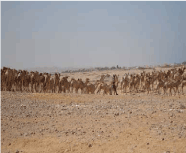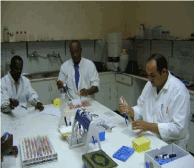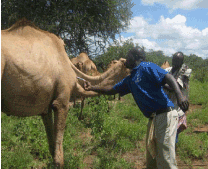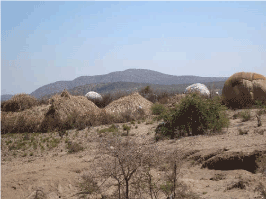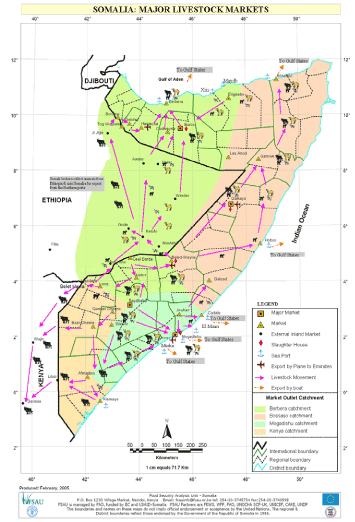| Research Article |
Open Access |
|
| Castiello Massimo, Innocente Sergio, Wamalwa Kinyanjui*, Munyua Solomon John Muchina, Matete George and Njue Sophycate |
| Food and Agriculture Organization of United Nations, Somalia, Nairobi |
| *Corresponding authors: |
Wamalwa Kinyanjui
Food and Agriculture Organization of United Nations
Somalia, Nairobi
E-mail: wamalwa.kinyanjui@fao.org |
|
| |
| Received December 15, 2011; Published August 12, 2012 |
| |
| Citation: Massimo C, Sergio I, Kinyanjui W, Muchina MSJ, George M (2012) Sustainable Livelihood: Potential Role and Quality Assurance of Camel Export Trade in Somalia. 1: 227. doi:10.4172/scientificreports.227 |
| |
| Copyright: © 2012 Massimo C, et al. This is an open-access article distributed under the terms of the Creative Commons Attribution License, which permits unrestricted use, distribution, and reproduction in any medium, provided the original author and source are credited. |
| |
| Abstract |
| |
| Increasing market integration is an unavoidable process for most pastoral societies. The livestock sector which accounts for about 80% of Somalia’s GDP plays a significant role in food security and socio-economic development of pastoral societies relying on enhanced market integration of local livelihoods and globalization of the economy. An estimated 70,000 camels are exported annually contributing substantially to the 80% of livestock exports in normal years. These exports have, in the past, been hit by recurrent trade bans by Somalia’s major livestock importing countries in the Middle East on suspicion of the presence of transboundary animal diseases. Primary and secondary data collection was carried out through field visitation and interviews of the relevant stakeholders using pre-tested questionnaire. Support measures put in place by donors and international agencies, including FAO Somalia, which included capacity building, support to existing veterinary institutions; disease surveillance, livestock treatments, vaccinations, fodder and pasture establishment and conservation and establishment of water catchments have gone a long way to ensure sustainable camel export trade. According to Bosasso port veterinary officer, there has been a steady increase in camel exports since livestock trade ban was lifted by KSA in October, 2009. This is essential if regions of Somalia are to achieve self reliance at national level and improve household food and economic security, to accelerate reduction in poverty levels and nutritional security. |
| |
| Keywords |
| |
| Capacity building; Livestock; Livelihoods; Sustainability; Trade; Household food and economic security |
| |
| Abbreviations |
| |
| CAC: Codex Alimentarius Commission; FAO: Food and Agriculture Organization of the United Nations; FSNAU: Food Security and Nutrition Analysis Unit; GCC: Gulf Cooperative Council; GDP: Gross Domestic Product; HH: House Holds; ILRI: International Livestock Research Institute; KSA: Kingdom of Saudi Arabia; NGO: Non-Governmental Organizations; OIE: World Animal Health Organization; RRRRL: Rapid Response and Rehabilitation Rural Livelihood; RVF: Rift Valley Fever; SPS: Sanitary and Phytosanitary; TAD: Trans-Boundary Animal Diseases; UAE: United Arab Emirates; UN: United Nation; WHO: World Health Organization; WTO: World Trade Organization |
| |
| Introduction |
| |
| Access to external markets for livestock and livestock products is associated with positive contributions to the national economies of the exporting countries as it earns them much needed foreign exchange, but with often unapparent direct benefits to the poorer sectors of the society, particularly poor rural pastoral producers [1]. The Somali and Middle East export enterprises demand quality animals and animal products, complicating opportunities for small-scale producers who have to struggle to cope as effective contributors given among other constraints, their small enterprise size, traditional (non-commercial) management of animals, lack of consistency in terms of animal quality, inadvertent occasional use of drugs with residue potential and poor control programs for trans-boundary, emerging and re-emerging animal diseases in developing countries [1]. Despite these short comings, however, livestock production and marketing in regions of Somalia is not only a major occupation but also a crucial source of household food and economic security and foreign exchange earnings. |
| |
| The benefits of the Somali livestock trade is not limited to regions of Somalia as it has been shown that an estimated 35-50% of the livestock exported through the ports of Berbera and Bosasso originate from regions of Somalia while 50-65% of exports are believed to originate from Ethiopia [2]. Trekking is the main means of livestock transport especially camels and cattle to secondary markets for sell or to ports of export [3]. This is a major challenge to traders as it fuels conflict over land along the trade routes, grazing and watering resources in addition to animals becoming susceptible to weight loss and death from starvation and opportunistic secondary bacterial infection if proper feed, water and health services are not provided [3]. |
| |
| Camel trade is greatly affected by among others access to water and fodder as traders and their trekkers often traverse areas without well defined access rights to the limited available resources yet most of the trekking to secondary markets or to ports for export is through regions where water, pasture and fodder are scarce. The land through which trekking is done almost yields no crops and water is often insufficient for human consumption let alone for livestock use. Thus, people and their livestock are forced by circumstances to compete for available scarce resources [2,4,3]. |
| |
| Despite the continuing conflict, that followed the collapse of the central Somalia government in 1991 that remolded the Somali socioeconomic fabric, the export trade has been a traditional feature of the country’s economy since 1884 when the country adopted a more exportoriented economy to the Middle East countries when Somaliland was occupied as a British protectorate [5-7]. The Country’s livestock sector has often accounted for at least 40% of gross domestic product (GDP) providing the main source of Somali livelihoods thereby reducing poverty levels. Camel exports to Middle East (United Arab Emirates, Kingdom of Saudi Arabia, Oman) countries, Egypt and Yemen has been estimated at about 70,000 annually contributing substantially to the 80% of exports in normal years; free from trade bans and drought [8,9,3]. |
| |
| Live livestock exports have been through two major ports, namely; Berbera and Bosasso in addition to a smaller scale through ports of Mogadishu and Kismayo. It is, however, believed that many more are informally exchanged or traded with Ethiopia, Djibouti and Kenya. However, this trade has been interrupted by vicious cycle of trade bans on perceived outbreak of some trans-boundary animal diseases leading to a great loss in terms of revenue. The bans proved to be expensive – for example Somaliland alone lost up to US$ 435 million in export revenues while the pastoralists lost up to US$ 93 million in income due to the 2000 Rift Valley Fever related trade ban according to [10]. |
| |
| Camels show outstanding survival features when compared with other livestock in regions dominated by drought conditions, arid and semi- arid and desert lands. Under dry environments, camel's lactating period is longer than that of other species like cows. The demand for camels in the Middle East countries, especially Egypt, Kingdom of Saudi Arabia (KSA), United Arab Emirates (UAE), Oman, Kuwait, Yemen and Libya is high because of the pocket friendly price of its meat and the traditional belief of the potential medicinal value of their milk. In addition camels’ ability to withstand adverse weather conditions renders them easier to acclimatize once relocated. Moreover, risks from tuberculosis (TB) and Brucellosis are lower too. As a consequence, camel milk is especially utilized in the diets of children, sick and elderly persons [5]. |
| |
| However, camel export trade from Somalia and other developing countries in the Horn of Africa has been facing some challenges that include among others; the demand for high international standards of animal health set by the World Animal Health Organization (OIE), food safety standards set by Codex Alimentarius Commission (CAC) of FAO/ WHO [11] and Sanitary and Phytosanitary (SPS) agreement of WTO [12]. Other challenges that have affected livestock marketing include recurrent bans in export trade due to suspicions of outbreak of some trans-boundary animal diseases including Rift Valley Fever and Camel Pox, competition over scarce natural resources, dilapidated livestock marketing and veterinary infrastructure, poor animal health service delivery system and inadequate technically competent professional personnel, general insecurity, demand for export certification compliant with international standards of animal health and food safety standards by the importing countries. The progression towards a single entry point system for the Middle East market under the Gulf Cooperative Council (GCC) countries [12] means that irrespective of the country of entry into the GCC, the conditions of acceptance will be the same. This will serve to compound the situation. This paper describes steps taken by FAO Somalia programme, UN agencies and other implementing/ development partners to build the capacity of the private and public sectors in Somalia to promote a sustained export trade in live camels to meet the ever increasing demand from the Middle East and other emerging markets. |
| |
| Materials and Methods |
| |
| Data and information was collected from secondary and primary sources through: |
| |
| Secondary data and information |
| |
| Documents held by FAO and other UN agencies, NGOs and the public sector in regions of Somalia and available literature in libraries and internet. |
| |
| Primary data collection targeted |
| |
| Livestock quarantine holding grounds (Berbera and Bosasso) management, Ministry of livestock officials and Port veterinary officers (Berbera and Bosasso). |
| |
| Focused individual and group interviews |
| |
| Informal administration of a checklist of questions, key informant interviews and group discussions. |
| |
| Results |
| |
| Camel Export Trade |
| |
| In Somalia, majority of the poor in rural depend directly or indirectly on income derived from livestock sale. Camels also provide milk, meat, hides, leather and are used as pack animals during migration in addition to trading in them for other staples with lower costs per calorie. Camels from Somalia are mostly trekked to destination markets of Yemen, Egypt, Djibouti and Kenya or shipped from Berbera, Bosasso, Mogadishu and Kismayo ports to importing countries of the Middle East (Kingdom of Saudi Arabia, Egypt, United Arab Emirates, Oman, Qatar, Bahrain, Kuwait and Libya) for sale. Camels are in high demand in these countries since they can reproduce with minimal difficulties and produce an adequate amount of milk even during adverse weather conditions characteristic of these countries as compared to other domestic animals which have very low production ability. In addition, their meat, which is suitable for most local dishes, is cheaper compared to that of other species. Furthermore, camel milk is highly valued for its “presumed” medicinal value making it a sort after food commodity by pastoralists and other consumers. Table 1 below shows average numbers of camels exported through the ports of Berbera and Bosasso to the Middle East and other countries for the last 5 years. |
| |
|
|
Table 1: Number of camels exported through Berbera and Bosasso ports. |
|
| |
|
|
Table 2: Institutions that were interviewed. |
|
| |
| From (Table 1) above, it is apparent that there was a tremendous increase of camel export of 340% during 2010 as compared to 2009 exports. This was partly due to animal health and production interventions by FAO Somalia, UN agencies and other implementing/ development partners and the reinvigoration of livestock trade by the lifting of the trade ban by KSA in October 2009. Moreover, functional livestock quarantine stations at the port strictly adhered to stringent animal health standards of importing countries ensuring good quality animals for export. |
| |
| |
| Export ports and holding grounds |
| |
| Somalia has 4 major export ports, namely; Berbera, Bosasso, Mogadishu and Kismayo and other smaller ports of Merka and El Ma’an [14]. Berbera and Bosasso ports are in North West (Somaliland) and North East (Puntland) Somalia respectively while Mogadishu and Kismayo are in Central and Sothern Somalia. Berbera and Bosasso ports are supplied with livestock from adequately equipped and managed livestock quarantine holding stations with facilities like sheds, water and feed troughs, concentrates, salts and fodder and health services for livestock. The ports are backed by adequately equipped laboratories with trained and experienced local and international professionals who offer diagnostic services. Public personnel have been trained and equipped with knowledge and skills for screening export livestock against major trans-boundary animal diseases (TDAs) and any other disease as per the requirements of the importing countries before export [3]. |
| |
| The fodder is supplied from the wetter parts of Somalia while concentrates are imported from UAE, Oman and Yemen. As per the requirements by the importing countries in the Middle East, livestock is required to be held in the quarantine stations for a period of 3 weeks to undergo thorough routine checks against occurrence of any TADs (foot and mouth disease, rift valley fever, Peste des petit ruminants) through observation and laboratory tests as per the requirements of the importing countries. In addition the animals recover their body conditions in the process. For example, animals exported to KSA are required to undergo 100% Brucella and RVF test since testing negative against these two diseases is the standard requirement for all livestock imports into the country. |
| |
| Below are some of the feeds supplied at the livestock holding grounds or sold on markets |
| |
| Trainings and associated activities |
| |
| Export ports: Actors along the livestock trade chain have received considerable assistance from implementing and development partners including FAO Somalia. The support included putting in place port administration systems and training of their personnel. The trainings covered various aspects of safe livestock trade in accordance with international standards of Animal Welfare and Sanitary and Phytosanitary agreement set by World Trade Organization (WTO) and food safety standards set by Codex Alimentarius Commission of FAO/WHO and animal health standards set by World Animal Health Organization (OIE) (Figure-3,4). |
| |
|
|
Figure 1: Pasture on Lorries for sale Bosasso. |
|
| |
|
|
Figure 2: Livestock concentrates-Berbera. |
|
| |
|
|
Figure 3: Camels trekking to export. |
|
| |
|
|
Figure 4: Camels being loaded on a ship-Bosasso port port-Bosasso. |
|
| |
| Control of trans-boundary and other animal diseases (TADs): As a mitigation measure to stem frequent trade bans due to perceived outbreaks of TADs like Rift valley fever (RVF), Peste des petit ruminants (PPR), contagious bovine pleuropneumonia (CBPP) among others, FAO Somalia and other implementing and development partners have been involved in training of Community Animal Health Workers (CAHWs) in collaboration with local professional associations (Central Regions Livestock and Professionals Association-CERELPA, South-West Livestock Professionals Association-SOWELPA, Puntland Livestock Professionals Association-PULPA and United Livestock Professionals Association -ULPA) [3]. The trained veterinarians in collaboration with Kenya Agricultural Research Institute- Muguga (KARI-Muguga), were contracted by FAO Somalia and other implementing and development partners to carry out disease sero-surveillance on a regular basis. |
| |
| Furthermore, the CAHW trainees were supplied with kick start veterinary kits and basic drugs by FAO Somalia and other implementing and development partners to offer quality animal health services in addition to putting in place disease reporting mechanisms. This was done alongside vaccination campaigns against major transboundary animal diseases; Peste des petit ruminants, Contagious caprine pleuropneumonia, and sheep and goat pox and mass treatments of livestock against common diseases like Babesiosis, Anaplasmosis, wounds and Trypanosomiasis in addition to control of helminthoses by drenching and control of ectoparasites and vectors like ticks and tsetse flies which has been on-going. |
| |
| FAO Somalia and other implementing development partners have played a vital role of capacity building for both the private and public laboratory technologists and veterinarians who are charged with the responsibility of disease surveillance, monitoring, detection and certification procedures. FAO Somalia has in addition established basic diagnostic laboratories in 6 regions (Bay, Bakol, Gedo, Lower Juba, Lower Shabeelle and Middle Juba) in central and southern Somalia. These have been supplied with basic diagnostic reagents to enrich training provided to technical personnel to carry out the services and report to the central government (Figure 5,6). |
| |
|
|
Figure 5: Serum screening in the laboratory-Bosasso. |
|
| |
|
|
Figure 6: Camels treatment-Gardo. |
|
| |
| Support to fodder production and pasture improvement: To mitigate against the frequent and persistent severe drought shocks and conflicts over water and pasture that usually arise as camels and other livestock are trekked, FAO Somalia and other development partners provided seeds to pastoralists and agro-pastoralists to produce and conserve fodder to be used during drought, sold to animal traders and to quarantines at the ports. For example, fodder bulking involved 166 HHs and 110 hectares of land while fodder production involved 4,025 HHs and 5,256 hectares of land under the Rapid Response and Rehabilitation Rural Livelihood (RRRRL) project of the WB in 2009 alone. Moreover, 1,065 kg of grass and 591 kg of forage seeds were distributed with the aim of improving production and mitigate against drought shocks. |
| |
| The target groups were trained on pasture and fodder conservation methods to ensure proper preservation, continuous availability and maximum utilization of this commodity during drought season for pastoralists themselves and livestock traders. Sustained and continuous availability of fodder crops and pasture cushions camels and other livestock against deterioration of body conditions by the time they reach the secondary markets or final destinations. This further minimizes camel losses through deaths due to inadequate pastures and fodder which can otherwise provide a conducive environment for opportunistic secondary bacterial infection that take advantage of the animals’ compromised immunity as a result of inadequate feeds. Establishment of fodder and pasture conservation has further empowered the target groups economically thereby improving their livelihood as the groups derive some income from sale of the commodity to camel and other livestock traders. |
| |
| FAO has further trained the target groups and pastoralists in production and conservation of feeds from maize and sorghum stalks. This has ensured maximum utilization of the farm produce thereby pragmatically mitigating the drought shocks, sustaining livestock body conditions during droughts and contributed to the household income generating activities through sustained sales both to local and export traders (Figure 7). |
| |
|
|
Figure 7: Conserved maize & sorghum stalks-Borama. |
|
| |
| Water catchments: FAO Somalia rehabilitated several water catchments along the livestock stock routes to export markets. Sixty five (65) water catchments were rehabilitated along the livestock stock routes (Figure 8) in Somaliland and Puntland in 2009 under RRRRL project alone. These were specifically for livestock and human use to reduce conflict that usually arise while pastoralists and agro-pastoralists compete for the scarce water resource. Some of these water catchment areas also serve as livestock vaccination and mass treatment centers. |
| |
|
|
| |
| Discussion and conclusions |
| |
| From the survey and study, it was established that continuous trainings (Wamalwa et al. 2011), disease surveillance, treatments, and vaccinations of livestock have contributed to the sustained continued export of camels to the Middle East countries and regional markets. In addition, promoting availability of water, fodder and pasture along the livestock stock routes to markets has reduced vulnerability of livestock to deterioration of animal health and opportunistic secondary bacterial infection by the time they reach the destination markets in addition to reducing tension between camel trekkers and communities along the stock routes over water, fodder and pasture. According to Bosasso port veterinary officer (Dr. Mohammed Farah), 2000-3500 camels were being exported through the port monthly since the lifting of the trade ban in October, 2009 by KSA. The figure is expected to increase steadily especially during the month of Haji. |
| |
| Acknowledgements |
| |
| Disclaim |
| |
| The opinions expressed in this document do not represent in any way the position of FAO. The authors thank; Promoting an Internationally Competitive Somali Meat Industry (OSRO/SOM/608/ EC), Rapid Response Rehabilitation of Rural Livelihood Projects (RRRRLP; OSRO/SOM/808/WBK) implemented by FAO Somalia and funded by European commission and World Bank respectively. We thank Graham Farmer; the officer in-charge and Abdullahi Hussein and Sergio Innocente; the project managers respectively. We further acknowledge the port veterinary officers, Bosasso livestock holding ground laboratory officer in-charge, Dr Abougazia Khalid for their freely allowing FAO team into their facilities and sharing the information with the team. |
| |
| |
| References |
| |
- International Livestock Research Institute (ILRI) 2005: An appropriate level of risk: Balancing the need for sale livestock products with fair market access for the poor.
- Little DP (1998) Research Methods on Cross-Border Trade in the Horn of Africa: Further Observations from
- Masake R, Gathuma J, Wahome J, Saif AF, Kariuki J (2008) Somali Meat Sector Assessment from FAO Somalia database.
- Meedan M (2006) Drought, Famine and Conflict: Case from the Horn of Africa
- Michele N, Mathew BK, Mohammed AY and Fadhumo H M (2006) Milking Drylands: the Marketing of Camel Milk in North-East Somalia
- UN/WB 2006: SOMALI Joint needs Assessment Livelihood and Solutions for the Displaced. Cluster report.
- UN/WB (2008) Somali Reconstruction and Development Programme Deepening Peace and Reducing Poverty Volume I.
- UN/WB (2008) Somali Reconstruction and Development Programme Deepening Peace and Reducing Poverty Volume I
- Munyua S (2008) Report on market survey and meat marketing systems in Somaliland and Puntland from FAO Somalia database.
- Bradbury M (2008) Becoming Somaliland (African Issues).
- FAO/WB/EU (2004) Somalia: Towards a livestock sector strategy. Siteresources.
- Codex Alimentarius Commission (CAC) (2005) Code of Hygienic Practice for Meat.
- Gulf Co-operative Council (GCC)countries: Kingdom of Saudi Arabia, United Arab Emirates, Qatar, Bahrain, Oman and Kuwait.
- Mugunieri L, Costagli R, Osman IO, Oyieke SO, Jabbar M, et al. (2008) A rapid appraisal of institutions supporting Somali livestock export: improvement and diversification of Somali livestock trade and marketing project. ILRI Discussion Paper 14. Nairobi (Kenya): ILRI.
- Food Security Analysis Unit (FSAU) (2009) Technical Series; Report No V. 17 March 4, 2009; 2008/09 Post Deyr Analysis.
- Food Security and Nutrition Analysis (FSNAU) 2011; Post Deyr 2010/11; Technical Series Report No VI. 36.
- Food Security and Nutrition Analysis Unit (FSNAU) 2010: Technical Series; Report No VI. 31 March 3, 2010; 2009/10 Post Deyr Analysis.
- Gathuma MJ, Emilio A, Arasio LR (2008) Livestock Marketing Survey in Eastern Equatorial State.
- Port veterinary office 2009: Annual reports 2009 (Berbera and Bosasso).
- Wamalwa K, Massimo C, Ombui JN, Gathuma J (2011) Capacity Building: Benchmark for Production of Meat with Low Levels of Bacterial Contamination in Local Slaughterhouses in Somaliland: Tropical Animal Health and Production Journal.
|
| |
| |



